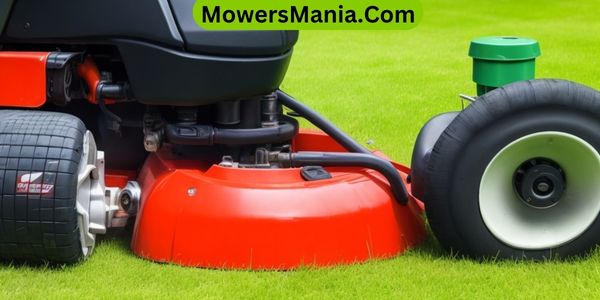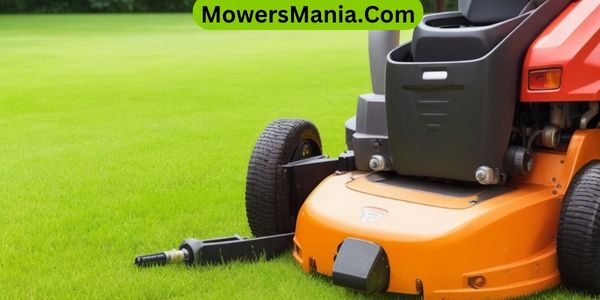Want to know how to bypass the safety switch on your lawn mower? This article will guide you through the process step by step.
By disconnecting the battery, locating the safety switch, and using a jumper wire, you can bypass the switch and get your mower running again.

Stay safe and test the bypassed switch to ensure it’s functioning properly. Follow these instructions and get back to mowing in no time!
Understanding the Purpose of the Safety Switch
The safety switch on your lawn mower serves as a crucial mechanism to prevent accidents and ensure your safety while operating the machine. This switch is designed to stop the engine and blades from spinning when certain conditions aren’t met.
For example, if you were to accidentally let go of the handle or step away from the mower while it’s still running, the safety switch would automatically shut off the engine and blades, preventing any potential injuries.
Additionally, the safety switch is also responsible for preventing the mower from starting if the key isn’t inserted or if the parking brake isn’t engaged. It acts as a fail-safe to ensure that the machine can only be operated when all necessary precautions have been taken.
Tools and Materials Needed for the Bypassing Process
To successfully bypass the safety switch on your lawn mower, there are a few essential tools you’ll need. These include a screwdriver, wire strippers, and electrical tape.
Additionally, you’ll need the necessary bypassing materials, such as a jumper wire or a resistor. With these tools and materials in hand, you can proceed with the safety switch bypass process.
Essential Tools Required
To bypass the safety switch on your lawn mower, you’ll need a few essential tools.
Here are the tools and materials needed for the bypassing process:
- Screwdriver: A screwdriver is necessary for removing screws and accessing the safety switch.
- Wire cutters: Wire cutters are required to disconnect the wires from the safety switch.
- Wire strippers: Wire strippers will help you remove the insulation from the wires, allowing for proper connections.
- Electrical tape: Electrical tape is needed to secure the connections and prevent any electrical hazards.
- Multimeter: A multimeter is useful for testing the circuit and ensuring that the bypass is successful.
These tools are essential for bypassing the safety switch on your lawn mower. Remember to exercise caution and follow proper safety procedures while working with electrical components.
Required Bypassing Materials
You will need several tools and materials for the bypassing process. To successfully bypass the safety switch on your lawn mower, gather the following items:
| Tools | Materials |
|---|---|
| Screwdriver | Electrical tape |
| Wire cutters | Wire connectors |
| Wire strippers | Heat shrink tubing |
| Multimeter | Insulated gloves |
The screwdriver will be used to remove any panels or covers necessary to access the safety switch. Wire cutters and strippers are needed to cut and strip the wires. The multimeter will help you test the continuity of the wires and ensure proper connections.
Electrical tape, wire connectors, and heat shrink tubing are essential for securing and insulating the bypassed wires.
Lastly, wearing insulated gloves is crucial to protect yourself from any potential electrical hazards during the bypassing process. Gather these tools and materials before proceeding to the next steps of bypassing the safety switch on your lawn mower.
Safety Switch Bypass Process
To bypass the safety switch on your lawn mower, gather the tools and materials mentioned in the previous subtopic. Once you have everything ready, follow these steps:
- Screwdriver: You’ll need a screwdriver to remove the bolts or screws holding the safety switch in place.
- Wire cutters: Use wire cutters to cut the wires connecting the safety switch to the mower’s electrical system.
- Wire strippers: With wire strippers, remove the insulation from the ends of the cut wires to expose the bare metal.
- Wire connectors: Connect the bare ends of the wires using wire connectors, ensuring a secure connection.
- Electrical tape: Wrap electrical tape around the wire connectors to insulate and protect the connections.
Step 1: Disconnecting the Battery for Safety

Disconnecting the battery is an important step to ensure safety when bypassing the safety switch on your lawn mower.
By doing this, you eliminate the risk of accidental starts or electrical shocks while working on the mower. To disconnect the battery, locate the battery compartment, which is usually near the engine or under the seat.
Open the compartment and find the battery terminals, one positive (+) and one negative (-). Using a wrench or pliers, loosen the nuts or bolts holding the battery cables in place. Start with the negative terminal and remove it first, followed by the positive terminal.
Carefully lift the battery out of the compartment and set it aside in a safe place. Now that the battery is disconnected, you can proceed with bypassing the safety switch on your lawn mower.
Step 2: Locating the Safety Switch on Your Lawn Mower
To begin, you need to understand the purpose of the safety switch on your lawn mower. It’s designed to prevent accidents and ensure your safety while operating the machine.
However, there may be situations where you might consider bypassing the safety switch. It’s important to be aware of the potential risks involved and explore alternative options before proceeding.
Purpose of Safety Switch
Locating the safety switch on your lawn mower is vital for understanding its purpose. The safety switch serves as an important feature to ensure the well-being of the operator and prevent accidents.
Here are five reasons why the safety switch is an essential component of your lawn mower:
Understanding the purpose of the safety switch can help you operate your lawn mower safely and effectively.
Potential Risks Involved
To ensure your safety while operating your lawn mower, it is crucial that you know where the safety switch is located on your machine. By understanding its location, you can avoid potential risks and prevent accidents.
The safety switch on a lawn mower is typically located in a convenient and easily accessible spot. To help you locate it, here is a table that outlines the common locations of safety switches on different types of lawn mowers:
| Lawn Mower Type | Safety Switch Location |
|---|---|
| Push Mowers | Near the handle |
| Riding Mowers | Under the seat |
| Electric Mowers | On the control panel |
| Self-Propelled | Near the handle |
Knowing where your safety switch is located will allow you to quickly and easily access it in case of an emergency or when you need to disengage the mower.
Always prioritize your safety and familiarize yourself with the safety features of your lawn mower.
Alternatives to Bypassing
There are safer options available instead of bypassing the safety switch on your lawn mower. Bypassing the safety switch can be dangerous and increase the risk of accidents. Instead, consider these alternatives:
Step 3: Bypassing the Safety Switch Using a Jumper Wire
Connect the jumper wire to bypass the safety switch on your lawn mower. This step involves creating a direct connection between the two terminals of the safety switch, effectively tricking the mower into thinking the switch is engaged at all times.
Here’s how you can do it:
- Start by locating the safety switch on your lawn mower. It’s usually located near the handle or on the side of the mower deck.
- Once you have located the safety switch, disconnect the wires connected to it. This will allow you to work with the wires more easily.
- Take the jumper wire and connect one end to the terminal where the wire from the safety switch was originally connected.
- Connect the other end of the jumper wire to the terminal where the other wire from the safety switch was connected.
Step 4: Testing the Bypassed Safety Switch for Functionality

After bypassing the safety switch on your lawn mower, it’s important to test its functionality to ensure that the bypass was successful.
Here are the steps to test the bypassed safety switch:
- Start the lawn mower: Begin by starting the lawn mower as you normally would. If the bypass was successful, the mower should start without any issues.
- Engage the blades: Next, engage the blades by pulling the blade engagement lever or pressing the appropriate button. The blades should start spinning smoothly.
- Move the mower: Test the functionality of the bypassed safety switch by moving the lawn mower forward and backward. The mower should respond to your commands without any interruptions.
- Stop the blades: Disengage the blades by releasing the blade engagement lever or pressing the button again. The blades should come to a complete stop.
- Turn off the mower: Finally, turn off the lawn mower by switching the ignition key to the off position. If the bypassed safety switch is working properly, the mower should shut down immediately.
Frequently Asked Questions [FAQs]
Can I Bypass the Safety Switch on My Lawn Mower Without Disconnecting the Battery First?
Yes, you can bypass the safety switch on your lawn mower without disconnecting the battery first. However, it is important to note that bypassing the safety switch can be dangerous and may void any warranties.
Is It Possible to Bypass the Safety Switch Without Using a Jumper Wire?
Yes, it’s possible to bypass the safety switch on your lawn mower without using a jumper wire. However, it’s important to note that tampering with safety features can be dangerous and may void your warranty.
Can I Bypass the Safety Switch on My Lawn Mower Even if I Don’t Know Its Location?
If you don’t know the location of the safety switch on your lawn mower, it may be difficult to bypass it. However, it’s always best to follow proper safety procedures and consult a professional.
What Are the Potential Risks or Dangers Associated With Bypassing the Safety Switch on My Lawn Mower?
Bypassing the safety switch on your lawn mower can pose potential risks and dangers. It may result in accidental starts, injury, or damage to property. Always follow proper procedures and consult a professional if unsure.
Will Bypassing the Safety Switch Affect the Warranty or Future Repairs on My Lawn Mower?
Bypassing the safety switch on your lawn mower may void the warranty and affect future repairs. It is important to consider the potential risks and dangers associated with tampering with the safety features.
Conclusion
In conclusion, bypassing the safety switch on your lawn mower can be done by following a few simple steps.
- Disconnect the battery for safety.
- Locate the safety switch.
- Use a jumper wire to bypass it.
After completing the process, test the bypassed safety switch to ensure it’s functioning properly.
Remember, it’s important to exercise caution and follow all safety guidelines when working with lawn mower equipment.



